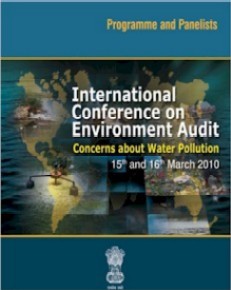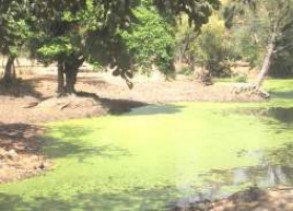Drinking and other Domestic Uses
International conference on environment audit - Concerns about water pollution - CAG (2010)
Posted on 10 Sep, 2010 05:15 PM This link on the CAG website provides the details of an international conference that was held on 15-16 March 2010, in the backdrop of the environmental audit proposed by the the Comptroller and Auditor General (CAG) of India, for management and conservation of the environment .
This link on the CAG website provides the details of an international conference that was held on 15-16 March 2010, in the backdrop of the environmental audit proposed by the the Comptroller and Auditor General (CAG) of India, for management and conservation of the environment .
The purpose of this conference was to deliberate on the causes of pollution, action taken by governments and civil society to address this and environmental, management and legal interventions needed to put lakes, rivers and ground water on the path of sustainability.
More than 20 experts on water and water pollution issues were invited to share their views as panelists during the conference. Apart from these distinguished panelists, the heads of supreme audit institutions from countries like Austria, Maldives, Bangladesh and Bhutan were also present to share their experiences regarding audit of water pollution in their countries.
Report of the exchange meeting on safeguarding future rural drinking water supply in Odisha, held at Bhubaneswar, between April 29-30, 2010
Posted on 05 Sep, 2010 10:23 PMA two day workshop on "Safe guard Future drinking water supply in Odisha", was organised on 29-30 April 2010. This event was as a result of cooperation between Gram Vikas, UNICEF, Deltares and ICCO (organisations involved in water supply and sanitation) and evolved out of a felt need to engage people from diverse fields to provide inputs for designing future courses of action.
Restoration of traditional small water bodies in Braj - The South Asian Journal of Tourism and Heritage
Posted on 01 Sep, 2010 02:28 PM This paper published in the South Asian Journal of Tourism and Heritage begins by highlighting the importance of the traditional small water bodies in Braj, commonly known as kunds, as important freshwater sources as well as an important part of the culture and the traditions of the area.
This paper published in the South Asian Journal of Tourism and Heritage begins by highlighting the importance of the traditional small water bodies in Braj, commonly known as kunds, as important freshwater sources as well as an important part of the culture and the traditions of the area.
There were 1000 such kunds, which used to be the source of fresh water in Braj in earlier times. The water was used for multiple purposes like irrigated agriculture, domestic uses, drinking water for cattle, bathing etc. Due to rapid urbanisation, lack of maintenance and prolonged negligence in the last 50-100 years, most of the kunds today have become silted up and are nearing extinction.
The impending crisis for fresh water has forced the planners and policy makers to take cognizance of these traditional water bodies and an urgent need has been identified for taking necessary measures to restore the kunds. The present study thus aims at understanding the reasons for deterioration of the kunds and makes some technical suggestions for revival of these kunds.
Movie reviews from 'Voices from the Waters 2010' film festival held in Bangalore
Posted on 28 Aug, 2010 08:58 AM
Reviews of some of the movies screened -
“Be water, My friend”
This UNESCO funded film, “Be water, My friend” tracks the research of Professor Gordon Lightgoot, an expert on ancient water monuments as he tries to understand and rectify the alarming drying up of Karez’s in northern Iragi region of Kurdistan.
Increasing groundwater dependency and declining urban water quality – A comparative analysis of four South Indian cities
Posted on 15 Aug, 2010 07:18 AMThis paper by the Institute of Social and Economic Change (ISEC) examines the extent of groundwater dependency and quality status in four South Indian cities viz., Hubli, Dharwad, Belgaum and Kolar cities. Widespread water shortage problems have resulted in increased dependency on groundwater with tapping the resources to unsustainable levels. In Karnataka, out of 208 urban local bodies that come under Karnataka Urban Water Supply and Drainage Board, 41 depend on groundwater.
Water Jobs via DevNetJobsIndia.org dated August 11th, 2010
Posted on 11 Aug, 2010 04:21 PMContent Courtesy: DevNetJobsIndia
- Program Associate (Drinking Water and Sanitation)
Coastal Salinity Prevention Cell
Location: Ahmedabad
Last Date: August 11, 2010
Fluoride free drinking water supply in North Gujarat: The rise of Reverse Osmosis plants as a cottage industry - A study by CAREWATER
Posted on 10 Aug, 2010 10:04 PMThe study by Carewater INREM Foundation explores the rise of Reverse Osmosis (RO) plants since 1970s as a cottage industry for providing fluoride free water supply in North Gujarat.
Groundwater contamination and rural water treatment in Gujarat - a discussion paper by Carewater INREM foundation
Posted on 07 Aug, 2010 06:09 PM The state is characterized by varied hydrogeology and vast areas are faced with typical groundwater quality problems like fluoride.
The state is characterized by varied hydrogeology and vast areas are faced with typical groundwater quality problems like fluoride.
Invitation for case study submission in water magazine
Posted on 06 Aug, 2010 11:26 AM
Our publication is coming up with the annual "Case Study Special Issue” in Sept. 2010. Its a collector’s issue, where we are covering leading industries across the globe.
Impacts of groundwater contamination with Fluoride and Arsenic: A report by CAREWATER
Posted on 04 Aug, 2010 10:25 AM
The field research study conducted by Carewater INREM Foundation attempts to establish the impacts of groundwater contamination with fluoride and arsenic in India. It maps the affliction severity, the medical cost and wage loss through a multi-location study in some villages in the States of Rajasthan, Andhra Pradesh, Karnataka and West Bengal.





